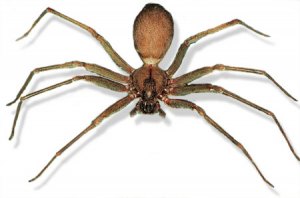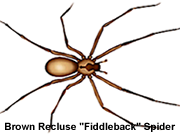

Brown Recluse Spider
location, identification, behavior, poison, bites treatment and first aid


location, identification, behavior, poison, bites treatment and first aid
Most adults will not feel any immediate pain or inflammation after the bite. But some people may show immediate signs of poisoning. The poison from the spider can cause the necrosis of the soft tissues. This will start with a local inflammation that is characterized by pain, edemas and reddening.
Common symptoms of a brown recluse spider bite include shivering, vomiting, nausea, fever, itching, shock and restlessness.
The bite may come out as an injury of about 1 to 2 3/4 inches which takes several months of healing and will leave you with unsightly scars. The bite is usually deep and will cause pain eventually. At first, the bite will appear swollen around the area of the bite. This will then expand and will change its color to red then the skin will then feel a bit hard. After a few hours of the bite, one may feel a sharp and hard sensation on the skin with signs of swelling and intense pain.
The injury will progress into to an ulcer. The ulcer will turn to have a dry bottom with blue/gray borders with reddish erythematous area along the periphery. The area where the bite will slowly turn red then will turn to a purplish colour after a day. This type of injury is also known as livedoid plaque. In worse cases, a surgery may be recommended to extract the necrotic tissue caused by the spider bite and to disguise the scar.
Serious symptoms related to the bite of a brown recluse spider include low platelet count, destruction of the red blood cells, blot clots in capillaries, inability to form clots, acute renal failure or kidney damage, coma, and death.